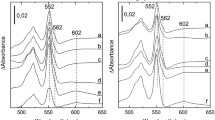Abstract
Anaerobic, bacterial reduction of water-soluble U(VI) complexes to the poorly soluble U(IV) mineral uraninite has been intensively studied as a strategy for in situ remediation of uranium-contaminated groundwater. A novel and potentially counteracting metabolic process, anaerobic, nitrate-dependent U(IV) oxidation, has recently been described in two bacterial species (Geobacter metallireducens and Thiobacillus denitrificans), but the underlying biochemistry and genetics are completely unknown. We report here that two diheme, c-type cytochromes (putatively c 4 and c 5 cytochromes) play a major role in nitrate-dependent U(IV) oxidation by T. denitrificans. Insertion mutations in each of the two genes encoding these cytochromes resulted in a greater than 50% decrease in U(IV) oxidation activity, and complementation in trans restored activity to wild-type levels. Sucrose-density-gradient ultracentrifugation confirmed that both cytochromes are membrane-associated. Insertion mutations in genes encoding other membrane-associated, c-type cytochromes did not diminish U(IV) oxidation. This is the first report of proteins involved in anaerobic U(IV) oxidation.


Similar content being viewed by others
References
Altschul SF, Madden TL, Schaffer AA, Zhang J, Zhang Z, Miller W, Lipman DJ (1997) Gapped BLAST and PSI-BLAST: a new generation of protein database search programs. Nucleic Acids Res 25:3389–3402
Beller HR (2005) Anaerobic, nitrate-dependent oxidation of U(IV) oxide minerals by the chemolithoautotrophic bacterium Thiobacillus denitrificans. Appl Environ Microbiol 71:2170–2174
Beller HR, Kane SR, Legler TC, Alvarez PJJ (2002) A real-time polymerase chain reaction method for monitoring anaerobic, hydrocarbon-degrading bacteria based on a catabolic gene. Environ Sci Technol 36:3977–3984
Beller HR, Chain PS, Letain TE, Chakicherla A, Larimer FW, Richardson PM, Coleman MA, Wood AP, Kelly DP (2006a) The genome sequence of the obligately chemolithoautotrophic, facultatively anaerobic bacterium Thiobacillus denitrificans. J Bacteriol 188:1473–1488
Beller HR, Letain TE, Chakicherla A, Kane SR, Legler TC, Coleman MA (2006b) Whole-genome transcriptional analysis of chemolithoautotrophic thiosulfate oxidation by Thiobacillus denitrificans under aerobic versus denitrifying conditions. J Bacteriol 188:7005–7015
Dorward DW (1993) Detection and quantitation of heme-containing proteins by chemiluminescence. Anal Biochem 209:219–223
Finneran KT, Housewright ME, Lovley DR (2002) Multiple influences of nitrate on uranium solubility during bioremediation of uranium-contaminated subsurface sediments. Environ Microbiol 4:510–516
Hole UH, Vollack KU, Zumft WG, Eisenmann E, Siddiqui RA, Friedrich B, Kroneck PMH (1996) Characterization of the membranous denitrification enzymes nitrite reductase (cytochrome cd 1) and copper-containing nitrous oxide reductase from Thiobacillus denitrificans. Arch Microbiol 165:55–61
Hunter DJB, Brown KR, Pettigrew GW (1989) The role of cytochrome c 4 in bacterial respiration. Cellular location and selective removal from membranes. Biochem J 262:233–240
Huntley JF, Conley PG, Hagman KE, Norgard MV (2007) Characterization of Francisella tularensis outer membrane proteins. J Bacteriol 189:561–574
Kadziola A, Larsen S (1997) Crystal structure of the dihaem cytochrome c 4 from Pseudomonas stutzeri determined at 2.2Å resolution. Structure 5:203–216
Larsen RA, Thomas MG, Postle K (1999) Protonmotive force, ExbB and ligand-bound FepA drive conformational changes in TonB. Mol Microbiol 31:1809–1824
Leitch FA, Brown KR, Pettigrew GW (1985) Complexity in the redox titration of the dihaem cytochrome c 4. Biochim Biophys Acta 808:213–218
Letain TE, Kane SR, Legler TC, Salazar EP, Agron PG, Beller HR (2007) Development of a genetic system for the chemolithoautotrophic bacterium Thiobacillus denitrificans. Appl Environ Microbiol 73:3265–3271
Reedy CJ, Elvekrog MM, Gibney BR (2008) Development of a heme protein structure-electrochemical function database. Nucleic Acids Res 36:D307–D313
Senko JM, Istok JD, Suflita JM, Krumholz LR (2002) In-situ evidence for uranium immobilization and remobilization. Environ Sci Technol 36:1491–1496
Tsai CM, Frasch CE (1982) A sensitive silver stain for detecting lipopolysaccharides in polyacrylamide gels. Anal Biochem 119:115–119
U.S. Department of Energy (2003) Bioremediation of metals and radionuclides, 2nd edn. Lawrence Berkeley National Laboratory
Zumft WG (1997) Cell biology and molecular basis of denitrification. Microbiol Mol Biol Rev 61:533–616
Acknowledgments
We thank Rachel Lindvall and Edmund Salazar (LLNL) for technical assistance. De novo peptide sequencing was performed by ProtTech, Inc. (Norristown, PA). This work was performed under the auspices of the U.S. Department of Energy by the University of California, Lawrence Livermore National Laboratory under contract No. W-7405-Eng-48.
Author information
Authors and Affiliations
Corresponding author
Electronic Supplementary Material
Rights and permissions
About this article
Cite this article
Beller, H.R., Legler, T.C., Bourguet, F. et al. Identification of c-type cytochromes involved in anaerobic, bacterial U(IV) oxidation. Biodegradation 20, 45–53 (2009). https://doi.org/10.1007/s10532-008-9198-y
Received:
Accepted:
Published:
Issue Date:
DOI: https://doi.org/10.1007/s10532-008-9198-y




